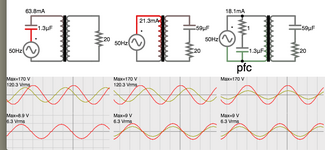OneRoom
Newbie
I'm trying to generate 6.3VDC at 300mA (for a vacuum tube filament) using the 18VAC winding of a transformer I already have. Ideally, I'd like to be able to regulate it using a LM317 or similar. The 18V winding doesn't have a center tap, so it seems like my options are to use a FWB rectifier, which would output ~24VDC...which leaves me a lot of voltage to "throw away," or try to use a half wave rectifier, which I think would only yield around ~7.8VDC, which is cutting it too close to use a LM317.
Are my calculations correct? All of this is assuming a 0.7V drop across the diodes. What would be the best way to go about this? Thanks!
Are my calculations correct? All of this is assuming a 0.7V drop across the diodes. What would be the best way to go about this? Thanks!
Last edited:
